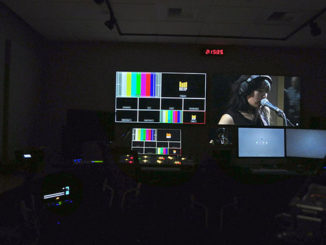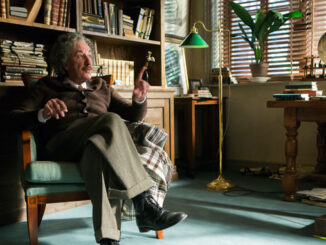
by Edward Landler
The late Ray Zone’s work with stereoscopic images goes back to converting flat images into 3D for comic books and graphic novels. As a hands-on practitioner, this led him to 3D work for television and motion pictures, and, as a writer, to his unique place as a groundbreaking journalist and historian of stereoscopic films and their technical evolution. This background has given the “3D King of Hollywood” a privileged view of the developments in stereoscopic cinema as the entertainment industry has shifted over to digital.
The publication of 3-D Revolution: The History of Modern Stereoscopic Cinema shortly before his unexpected death marks the completion of Zone’s fourth book on 3D film and the second volume of his comprehensive history of the medium. In the first volume — Stereoscopic Cinema and the Origins of 3D Film: 1838-1952, published in 2007, also by University Press of Kentucky — Zone delineated four separate epochs during which 3D movies evolved both as a technology and a cinematic art. That book was a detailed look at the first epoch, which he characterized as “the long novelty period for stereo cinema that lasted over a century.”
The new book — fully comprehensible on its own without requiring the reader to refer to the earlier volume — deals with the following three epochs, examining 3D and the film industry from historical, technical, business and artistic perspectives. Beginning with the release of Arch Oboler’s Bwana Devil (1952), the movie that set off the 1950s short-lived 3D boom, Zone’s chronology breaks down the epochs into the Era of Convergence, 1952-1985; the Immersive Age, 1986-2005; and Digital 3D Cinema, from 2005 to speculations on future evolution.
By naming the first era of major film industry use of 3D as that of “convergence,” Zone is not only referring to the technological convergence of dual-camera and dual-projector perspectives that create the illusion of depth. While he clearly explains in detail the technical aspects of this accomplishment, he also describes the convergence of the classical Hollywood narrative on the 1:33 to 1 ratio screen with the perceived amplification of depth at the aesthetic level. Seen at first as an attraction to get audiences away from their TVs and back to movie theatres, the 3D boom was cut off by the greater success of the more easily achieved widescreen format.
Throughout 3-D Revolution, the author presents an ongoing argument for the artistic and narrative viability of stereoscopic images beyond their intriguing technical capabilities.
Interest in stereoscopic film didn’t disappear. But it went underground — commercially in the form of 3D pornographic movies, both soft-core and hard, and technically in the rise of scientific and amateur organizations made up of individuals concerned with the further development of the process. The release of films like Comin’ at Ya in 1981, Friday the 13th Part III in 1982, Jaws 3D in 1983 and Starchaser: The Legend of Orin, the first animated 3D feature, in 1985, however, showed that the stereoscopic image still held mainstream appeal.
In 1986, Transitions — the first large-format 15/70mm IMAX 3D film — inaugurated the next epoch of stereoscopy and marked the dividing point between traditional 3D and the new, more immersive technology. Combining the amplification of depth perception with the widescreen format, the motion pictures of this era found popular new venues for exhibition: theme parks and IMAX theatres. Audiences in both venues were placed in situations where they were not aware of the film frame reaching to the edge of their peripheral vision and they reacted more intensely to the immersive image and surrounding sound. The theme park rides enhanced this, overwhelmingly sometimes, with experiential simulation heightened by vehicle motion.
In 2003, the release of Robert Rodriguez’s Spy Kids 3D in anaglyph stereoscope and, in 2004, the stereoscopic “re-purposing” of Robert Zemeckis’ The Polar Express for IMAX 3D — made easier by the original 2D’s three-dimensionally constructed computer animation — set the stage for the current era of digital 3D cinema. Zone seems to approach the advances of this era with unabashed relish as digital technology brings the visual format he so clearly loves to the brink of full acceptance in the industry.
Throughout 3-D Revolution, the author presents an ongoing argument for the artistic and narrative viability of stereoscopic images beyond their intriguing technical capabilities. In the final third of the book, he weaves this discussion into his descriptions of the innovations he observes in the digitally achieved 3D movies of the last few years. He effectively maps the marriage of narrative and stereoscopic effects in comprehensive overviews of a string of animated features — from Disney’s Chicken Little(2005) and Meet the Robinsons (2007) to DreamWorks’ Monsters vs. Aliens, Pixar’s Up and Henry Selick’s Coraline, all released in 2009.
Ray Zone describes the convergence of the classical Hollywood narrative on the 1:33 to 1 ratio screen with the perceived amplification of depth at the aesthetic level.
In Zone’s view, the visual storytelling of James Cameron’s Avatar (2009) represents the watershed of this evolution of subtler uses of depth along the “z-axis” that reaches from an infinite background to the space over the audience. Here, as elsewhere in the book, Zone clarifies the technical grounding of 3D so that terms like “z-axis,” “floating stereo window” and “inter-ocular spacing” make sense to the reader.
Much of 3-D Revolution reads like personal history since Zone was personally involved in the development of stereoscopic cinema for more than 25 years. A good number of times, the narrative breaks to transcripts of his interviews with key figures in 3D’s development, including stereoscopic supervisors Jayme Wilkinson, Phil “Captain 3D” McNally and Rob Engle.
As a parting gift, “3D King” Zone has left for us the most comprehensive and up-to-date history of how stereoscopic film attracts us through what he calls “the primal appeal of motion through space.”






